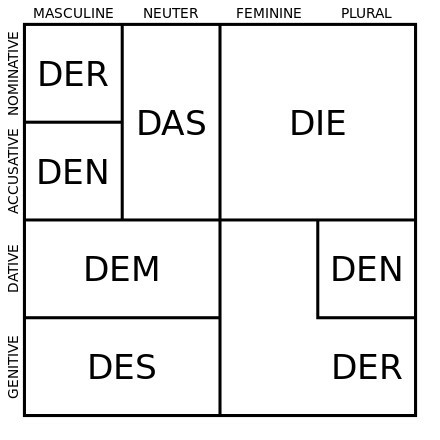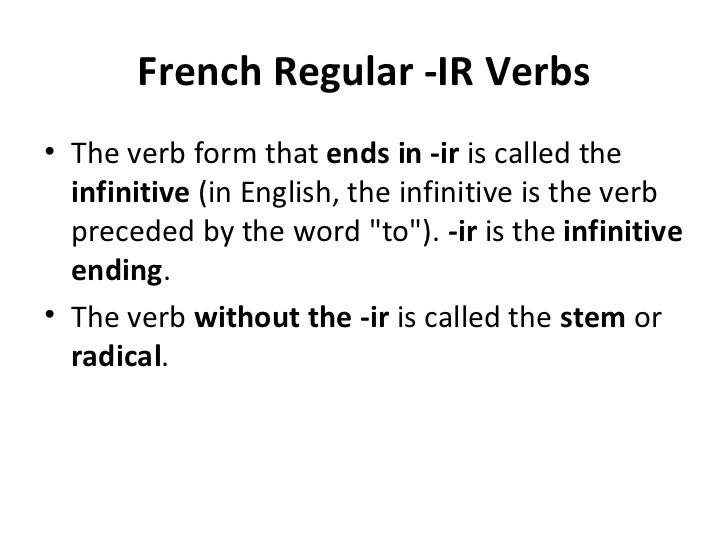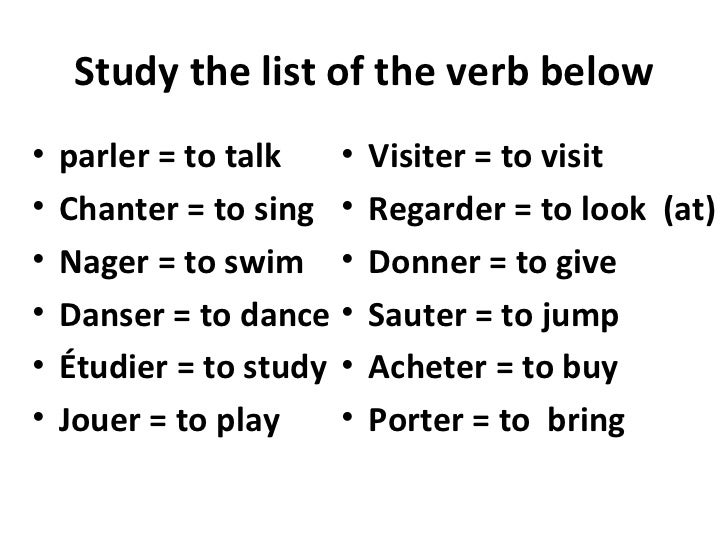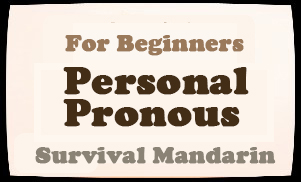German Regular Noun declension, n-declension and exceptions
Capitalized Nouns
One important thing as we get started: All nouns are written with the first letter capitalized.
“the house” is written as
“das Haus”.
Genders
There are three genders in German:
masculine (männlich),
feminine (weiblich) and
neuter (sächlich). Usually, the gender of a noun is determined by its ending.
The articles
der,
die and
das are used with nouns to indicate their gender:
- der Mann (the man) [Masculine Noun]
- die Frau (the woman) [Feminine Noun]
- das Kind (the child) [Neuter Noun]
It’s not easy to know which gender a noun is. There are a few rules for masculine, feminine and neuter nouns. However, usually there is no choice but to learn each word’s gender.

Declension
A noun in English, “house” for example, does not change even if we change the role it plays in a phrase.
The house is pretty (
“house” is the subject in this case)
We bought a house (
“a house” is the direct object).
As you see, the word house is not declined. You just add “s” in English to make the plural. It’s very simple.
Unfortunately, it is not always like this in German. This might cause you a bit of despair when you start learning German. For example, in the phrase, “Erkrankungen des Herzens”, the word “Herzens” (heart in genitive form) does not appear in the dictionary. That is because it is declined and, instead of that word, you have to look for “Herz” (heart in nominative form).
It is a bit complicated but don’t worry about it. you will get it.

Regular noun declension
As a general rule, an “-n” or an “-en” are added to all nouns in the dative plural. If the noun in the plural ends with “-n” or “-s,” nothing will be added.
Masculine or Neuter Nouns
An “-s” or an “-es” is added in the genitive singular. Sometimes both options are ok. In general, if a word ends with “-e”, an “-s” is added in the genitive and if it ends with “-s” or “-z” and “-es” is added.
Example for a neuter noun:
|
Singular |
Plural |
| Nominative |
das Gas |
die Gase |
| Accusative |
das Gas |
die Gase |
| Dative |
dem Gas
also: dem Gase |
den Gasen |
| Genitive |
des Gases |
der Gase |
Although it is not very common today, sometimes an “-e” is added to the dative singular. Nowadays, you can see this is some phrases:
Ich gehe nach Hause
I am going home
Hause is the old declension in the dative singular for das Haus (house).
Dem deutschen Volke
For the German people
Volke is the classic declension of
Volk (people) in the dative singular.
Feminine Nouns
Feminine nouns do not change in the genitive singular.
|
Singular |
Plural |
| Nominative |
die Kraft |
die Kräfte |
| Accusative |
die Kraft |
die Kräfte |
| Dative |
der Kraft |
den Kräften |
| Genitive |
der Kraft |
der Kräfte |
Interestingly, a large portion of feminine plural nouns end with “-n,” meaning that luckily the majority of feminine plural nouns do not change.
|
Singular |
Plural |
| Nominative |
die Lampe |
die Lampen |
| Accusative |
die Lampe |
die Lampen |
| Dative |
der Lampe |
den Lampen |
| Genitive |
der Lampe |
der Lampen |
N-Declension
Some
masculine nouns and a few
neuter ones have a declension that is different from the usual one and it is called the “N-Deklination” (N-Declension).
|
Singular |
Plural |
| Nominative |
der Kunde |
die Kunden |
| Accusative |
den Kunden |
die Kunden |
| Dative |
dem Kunden |
den Kunden |
| Genitive |
des Kunden |
der Kunden |
If we look closely at all of the forms except for the nominative singular, they have an “-n” ending. This is why it is called
“N-Deklination”.
Sometimes, an
“-en” is added instead of adding an
“-n”. For example, the noun
“Mensch”.
Examples of nouns with n declension
- Most masculine nouns ending with “-e” but not der See or der Käse or der Deutsche and which represents professions or nationalities or people such as der Experte.
- Many nouns that represent professions or nationalities or people such as: der Herr, der Astronom, der Architekt.
- Latin or Greek words ending with:-at as in der Soldat, der Advokat, der Diplomat.-ant as in der Elefant, der Diamant, der Lieferant.
-ent as in der Student.
-ist as in der Journalist, der Zivilist, der Violinist, der Polizist.
N-Deklination + genitive with “ns”
Sometimes, the genitive is formed with
“-ns” instead of
“-n”.
|
Singular |
Plural |
| Nominative |
der Name |
die Namen |
| Accusative |
den Namen |
die Namen |
| Dative |
dem Namen |
den Namen |
| Genitive |
des Namens |
der Namen |
Examples of nouns with genitive
“-ns”: der Friede, der Name, der Funke, der Gedanke, der Glaube, der Same, der Wille, der Buchstabe.
Exceptions
Doubling the -s
Some nouns that end with
“-s” have another
“-s” added in the declension.
|
Singular |
Plural |
| Nominative |
der Bus |
die Busse |
| Accusative |
den Bus |
die Busse |
| Dative |
dem Bus |
den Bussen |
| Genitive |
des Busses |
der Busse |
A short reminder about pronunciation: The “ss” indicates that the preceding vowel is shortened.
Das Herz
“Herz” has an irregular declension. It is also one of the few neuter nouns with the
“-n” declension.
|
Singular |
Plural |
| Nominative |
das Herz |
die Herzen |
| Accusative |
das Herz |
die Herzen |
| Dative |
dem Herzen |
den Herzen |
| Genitive |
des Herzens |
der Herzen |
]]>



 Adjective Declensions
Adjective Declensions French Irregular -RE Verbs
French Irregular -RE Verbs
 There are five main kinds of verbs in French: regular -ER, -IR, -RE; stem-changing; and irregular. Once you’ve learned the rules of conjugation for each of the first three kinds of verbs, you should have no problem conjugating regular verbs in each of those categories. The smallest category of regular French verbs -RE verbs.
The verb form that ends in -RE is called the infinitive (in English, the infinitive is the verb preceded by the word “to”), and -RE is the infinitive ending.
There are five main kinds of verbs in French: regular -ER, -IR, -RE; stem-changing; and irregular. Once you’ve learned the rules of conjugation for each of the first three kinds of verbs, you should have no problem conjugating regular verbs in each of those categories. The smallest category of regular French verbs -RE verbs.
The verb form that ends in -RE is called the infinitive (in English, the infinitive is the verb preceded by the word “to”), and -RE is the infinitive ending.
 étendre to stretch
fondre to melt
pendre to hang, suspend
perdre to lose
prétendre to claim
rendre to give back, return
répandre to spread, scatter
répondre to answer
vendre to sell
étendre to stretch
fondre to melt
pendre to hang, suspend
perdre to lose
prétendre to claim
rendre to give back, return
répandre to spread, scatter
répondre to answer
vendre to sell
 There are five main kinds of verbs in French: regular -ER, -IR, -RE; stem-changing; and irregular. Once you’ve learned the rules of conjugation for each of the first three kinds of verbs, you should have no problem conjugating regular verbs in each of those categories. Regular -IR verbs are the second largest category of French verbs.
The verb form that ends in -IR is called the infinitive (in English, the infinitive is the verb preceded by the word “to”), and -IR is the infinitive ending.
There are five main kinds of verbs in French: regular -ER, -IR, -RE; stem-changing; and irregular. Once you’ve learned the rules of conjugation for each of the first three kinds of verbs, you should have no problem conjugating regular verbs in each of those categories. Regular -IR verbs are the second largest category of French verbs.
The verb form that ends in -IR is called the infinitive (in English, the infinitive is the verb preceded by the word “to”), and -IR is the infinitive ending.


 How to conjugate regular -ER verbs in French
There are five main kinds of verbs in French: regular -ER, -IR, -RE; stem-changing; and irregular. Once you’ve learned the rules of conjugation for each of the first three kinds of verbs, you should have no problem conjugating regular verbs in each of those categories. The majority of French verbs are regular -ER verbs – see the next page for a list of some common -ER verbs.
The verb form that ends in -ER is called the infinitive (in English, the infinitive is the verb preceded by the word “to”), and -ER is the infinitive ending.
How to conjugate regular -ER verbs in French
There are five main kinds of verbs in French: regular -ER, -IR, -RE; stem-changing; and irregular. Once you’ve learned the rules of conjugation for each of the first three kinds of verbs, you should have no problem conjugating regular verbs in each of those categories. The majority of French verbs are regular -ER verbs – see the next page for a list of some common -ER verbs.
The verb form that ends in -ER is called the infinitive (in English, the infinitive is the verb preceded by the word “to”), and -ER is the infinitive ending.

 jouer to play
laver to wash
manger* to eat
nager* to swim
parler to talk, to speak
passer to pass, spend (time)
penser to think
jouer to play
laver to wash
manger* to eat
nager* to swim
parler to talk, to speak
passer to pass, spend (time)
penser to think porter to wear, to carry
regarder to watch, to look at
rêver to dream
sembler to seem
skier* to ski
travailler to work
trouver to find
visiter to visit (a place)
voler to fly, to steal
*All regular -ER verbs are conjugated according to the regular -ER verb conjugation pattern, except for one small irregularity in verbs that end in -ger and -cer, which are known as spelling-change verbs.
porter to wear, to carry
regarder to watch, to look at
rêver to dream
sembler to seem
skier* to ski
travailler to work
trouver to find
visiter to visit (a place)
voler to fly, to steal
*All regular -ER verbs are conjugated according to the regular -ER verb conjugation pattern, except for one small irregularity in verbs that end in -ger and -cer, which are known as spelling-change verbs. Your First Words!
This lesson you will learn personal pronouns.
Your First Words!
This lesson you will learn personal pronouns.


 ou hear the answer. Remember though, as explained above, synonyms are often used.
ou hear the answer. Remember though, as explained above, synonyms are often used.
